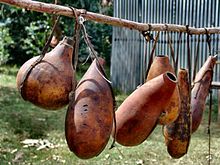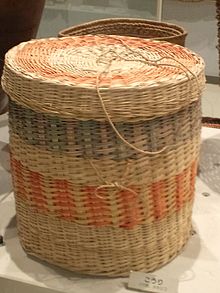容器
容器 (英语:Container) 是一种基础工具[1][2]。泛指任何可以用于容纳其它物品的工具,可以部分或完全封闭,被用于容纳、储存、运输物品[3]。物体可以被放置在容器中,而容器则可以保护内容物。




历史 编辑
人类使用容器的历史至少有十万年,甚至可能有数百万年的历史[4]。第一个容器可能是用于储存食物[4][5] ,这让食物能保存更长的时间,也能便于携带,还能免受其它动物的侵扰。储存食物的容器对人类社会的发展具有重大的意义,这在灵长类动物之中是一种独有的行为.[6]。最早的容器可能是自然界中原有的物体,例如在塔鲁族[7]和夏威夷族[8] 的文化中,有使用空心葫芦的案例[9]。在这之后,出现了篮、木器和陶器。
随着人类的技术不断演进,新的材料、新的生产方式接连诞生,容器的形式也不断改变[10]。最早的玻璃瓶是在腓尼基生产的,在塞浦路斯和罗得岛一带挖掘出腓尼基人所生产的透明玻璃瓶,长度自3英寸至6英寸不等[11]。这些腓尼基人在公元前创作的作品被推测用于装载香水及其他物品[12],古罗马人从腓尼基人那儿学到了玻璃的制作方法,并且制造了很多精细的玻璃瓶,大小相对较小。到了18世纪初,玻璃瓶的尺寸已经有公定的标准[13]。
1810年,法国人Philippe de Girard造访伦敦,他找上英国商人彼得·杜兰作为自己的代理人以推销自己的崭新想法——锡罐[14]。而罐头这个概念是源自法国厨师尼古拉·阿佩尔,阿佩尔之家成为了世界上第一家商业罐头工厂。
大规模运输作业一直是一个大难题,主要是因为20世纪时使用的木制货柜容易破损,这也让海关官员在检查货物进口时缺乏标准程序[13]。现代的标准货柜起源于1950年代,且很快就普及至各地。电脑辅助设计让容器的设计变得更专业化、产品也更为精准[15]。
现代特色 编辑
在设计容器时,有几种必须考虑的要点:
光是具有防震、防潮的功能,可不能算得上一个好的容器。精心设计的容器必须是易于使用的,也就是说、使用者必须要能很轻易地开启或关闭容器,放入或取出内容物,即使在运输时也不减损其功能。此外、良好的容器必须要有清晰而便利的标示,形状要有利于堆放和储存,在使用寿命将至时,必须要能便于回收。[16]
容器的类型 编辑
以下列举数种常见的容器:
参考文献 编辑
引用 编辑
- ^ David P. Braun, "Pots as Tools", in J. A. Moore and A. S. Keene, eds., Archaeological Hammers and Theories (1983), pp. 108-134.
- ^ Karen Gayle Harry, Stephanie Michelle Whittlesey, Trixi Bubemyre, Pots, Potters, And Models: Archaeological Investigations at the SRI Locus of the West Branch Site, Tucson, Arizona (2005), p. 283: "The perspective taken in this chapter is that ceramic containers are tools (Braun 1983) and, as a crucial part of the technological repertoire, can provide considerable information about activity organization, production technology, food-preparation and storage technology, settlement function, and economic organization".
- ^ Soroka, W. Illustrated Glossary of Packaging Terms. Institute of Packaging Professionals. 2008: 51. ISBN 1-930268-27-0.
- ^ 4.0 4.1 Clive Gamble, Origins and Revolutions: Human Identity in Earliest Prehistory (2007), p. 204.
- ^ David A. Munro, A Place For Everything (1968), p. 92.
- ^ Bernard Grant Campbell, Human Evolution: An Introduction to Mans Adaptations (2009), p. 306.
- ^ Sameera Maiti, The Tharu: Their Arts and Crafts (2004), p. 178.
- ^ Irving Jenkins, The Hawaiian Calabash (1989), p. 5.
- ^ Chuck Groth, Exploring Package Design (2005), p. 3.
- ^ Lewandowski, Krzysztof. Growth in the Size of Unit Loads and Shipping Containers from Antique to WWI.. Packaging Technology and Science. 2016, 29 (8-9): 451–478 [2017-01-13]. ISSN 1099-1522. (原始内容存档于2016-11-15).
- ^ Perrot and Chipiez, Histoire de l'art, v iii, 734-744
- ^ George Rawlinson, History of Phoenicia, 1889, Green Longmans publisher, 583 pages
- ^ 13.0 13.1 Warren Belasco, Roger Horowitz, Food Chains: From Farmyard to Shopping Cart, p. 98-99.
- ^ Geoghegan, Tom. BBC News – The story of how the tin can nearly wasn't. Bbc.co.uk. 2013-04-21 [2013-06-04]. (原始内容存档于2013-06-06).
- ^ Geoff A. Giles, Design and Technology of Packaging Decoration for the Consumer Market (2000), p. 82: "Container designers also found that shrink sleeves gave them new-found freedom to design containers that until then had been viewed as impossible to decorate".
- ^ Anthony F. Buono, Henri Savall, Socio-economic Interventions in Organizations (2007), p. 231.
来源 编辑
- 书籍
- Yam, K.L., "Encyclopedia of Packaging Technology", John Wiley & Sons, 2009, ISBN 978-0-470-08704-6